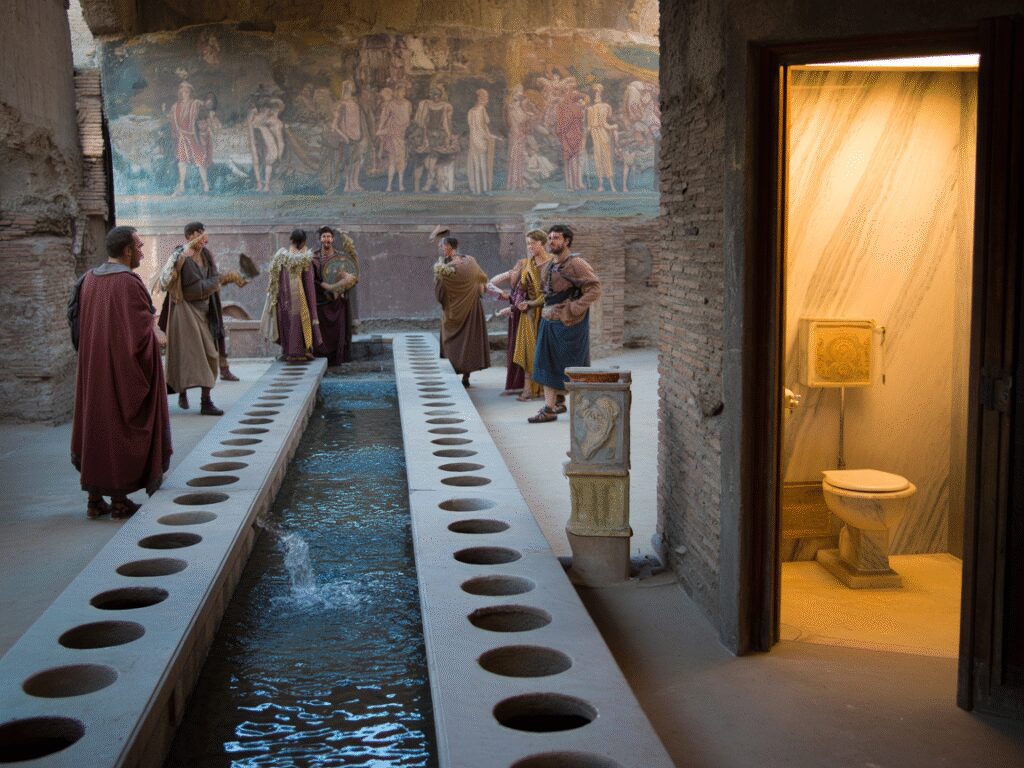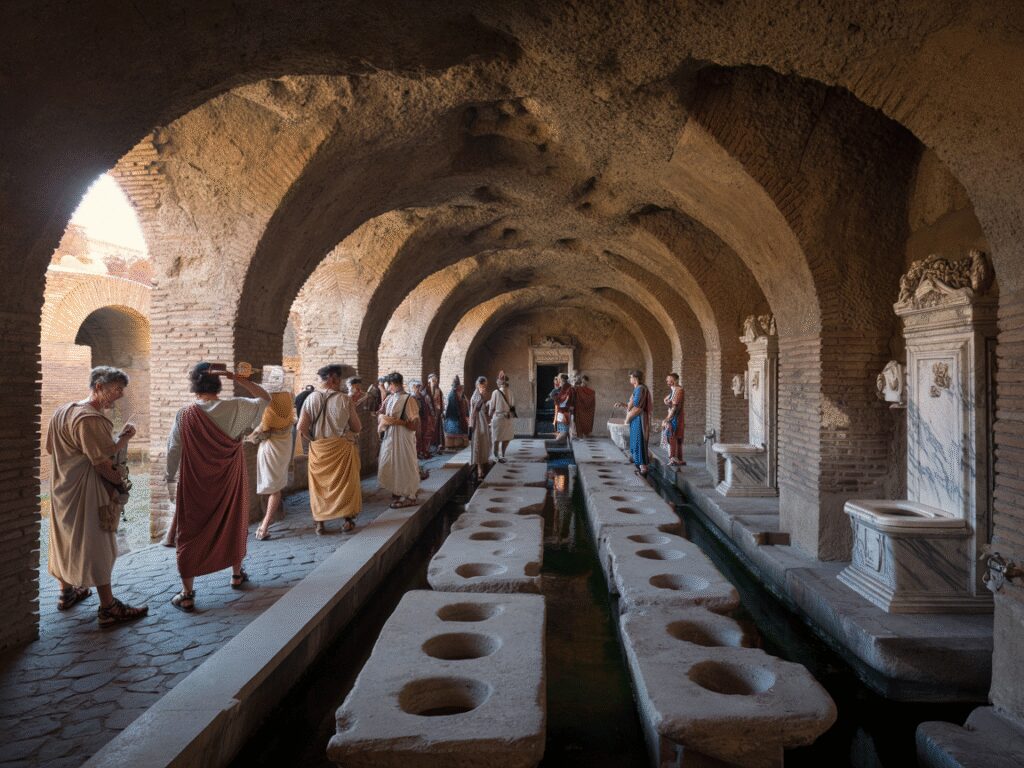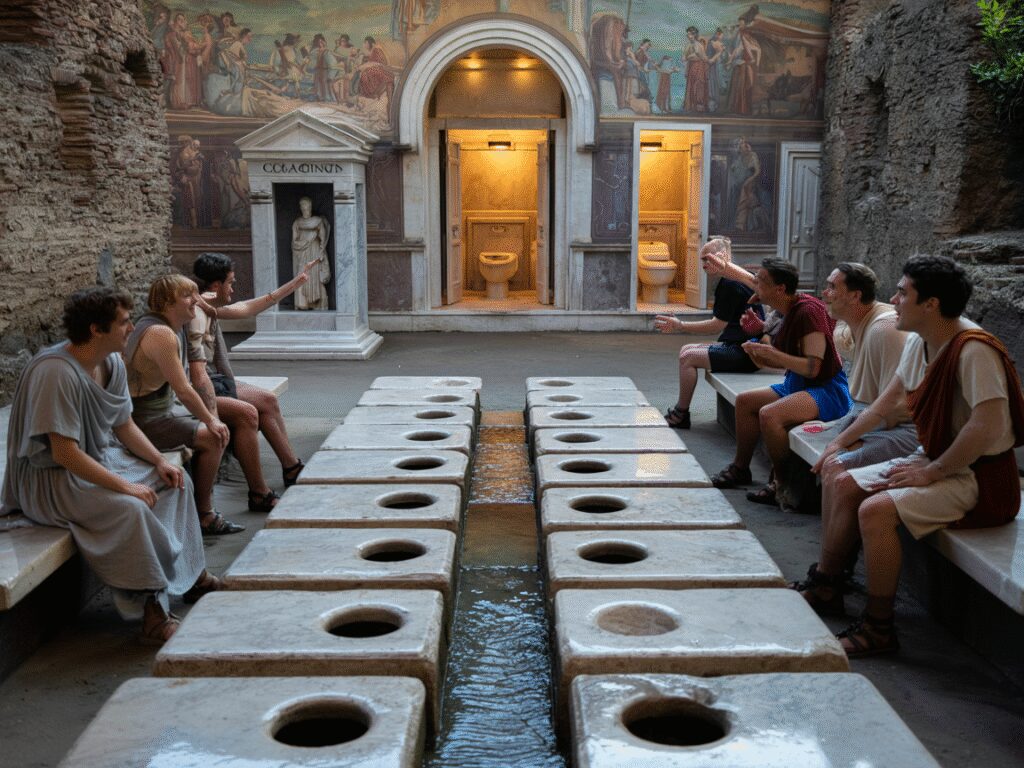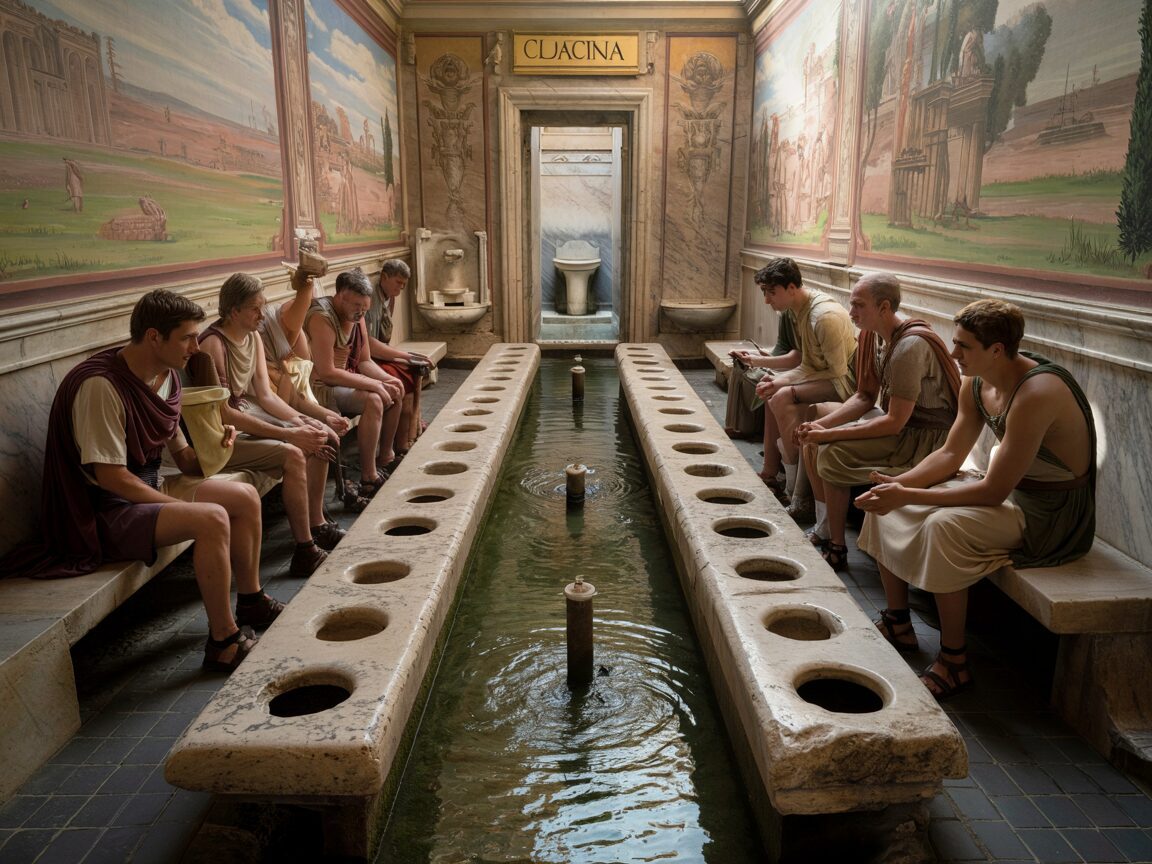Roman public toilets were more than just functional necessities in ancient sanitation systems. These communal latrines, known as foricae, played a significant role in Roman life. While their main purpose was hygiene and waste management, they also served as lively social spaces where people gathered, shared ideas, and interacted with each other on a daily basis.
Key points to consider:
- Roman public toilets provided essential hygiene facilities supported by advanced engineering.
- They served as important venues for socializing beyond the well-known bathhouses.
- These spaces reflect a complex relationship between cleanliness and community life in ancient Rome.
Understanding Roman public toilets and hygiene gives us valuable insights into how sanitation infrastructure also functioned as social hubs, enhancing both urban living and cultural practices in the Roman world. This intricate connection between public sanitation and societal engagement is just one aspect of the larger political instability and weak leadership that contributed to the decline of the Western Roman Empire. Such internal conflicts often overshadowed even the formidable power of the Roman military, which represented the empire’s vastness and diversity.
Furthermore, during this period, the evolution of Roman sculpture demonstrates how art captured the realism and power dynamics of society, serving as a tool for political propaganda. Additionally, studying the Roman Pantheon, consisting of gods representing power, justice, and wisdom, offers further understanding of the values and beliefs that shaped Roman life.

The Design and Engineering of Roman Public Toilets
Roman public toilets, known as foricae, showcased advanced sanitation engineering that combined functionality with community needs. Architecturally, these latrines featured long stone benches with multiple holes evenly spaced to accommodate several users simultaneously. This design encouraged social interaction while maximizing space efficiency.
Efficient Waste Management
Beneath the seating, a continuous channel of flowing water carried waste away, preventing stagnation and odors. This system connected directly to extensive underground drainage networks like the Cloaca Maxima, one of the earliest sewage systems in history. The Cloaca Maxima efficiently transported waste out of the city, demonstrating Rome’s pioneering approach to urban hygiene.
Clean Water Supply
Clean water essential for flushing and handwashing came from Rome’s intricate aqueducts. These aqueducts supplied fresh water continuously, enabling latrines to maintain cleanliness through constant flow. Some public toilets incorporated innovative flushing mechanisms where water discharged from basins was directed into the waste channels, reducing buildup and maintaining sanitary conditions.
Focus on Hygiene
Water basins installed near the seats allowed users to wash their hands after use – a practice supported by the availability of running water. This focus on hygiene was remarkable for its time and highlights how Roman engineers prioritized both functional waste removal and user cleanliness in public spaces.
The integration of these features made foricae not only practical but also technologically sophisticated elements within Rome’s urban fabric.

Hygiene Practices and Health Considerations in Public Latrines
The xylospongium: A Unique Communal Hygiene Tool
Roman public toilets featured a unique communal hygiene tool known as the xylospongium—a sponge attached to a stick, used for personal cleaning after defecation. This device was shared among users, rinsed between uses in basins filled with vinegar or salt water to reduce bacterial contamination. While practical, this method presented inherent health risks.
Disease Transmission through Communal Latrine Use
Communal use of latrines facilitated the spread of diseases such as typhus and trench fever, transmitted primarily through fecal-oral routes. The close proximity of users and shared cleaning implements increased the likelihood of infection. Despite these dangers, public latrines remained essential urban fixtures due to their sanitary design that minimized direct contact with waste.
Sanitation Laws and Public Health Measures
Strict Roman sanitation laws governed waste disposal and water supply management. Authorities enforced regulations to prevent contamination of drinking water sources by human waste, crucial for maintaining public health in densely populated cities. These laws helped control outbreaks by mandating separation between sewage channels and potable water systems.
Balancing Innovation and Vulnerability in Communal Hygiene
Roman efforts in communal hygiene balanced innovative sanitation engineering with the realities of disease transmission. The use of the xylospongium illustrates both resourcefulness and vulnerability within these social spaces, highlighting tensions between public convenience and health safety.

Public Toilets as Vibrant Social Hubs
Roman public toilets were far more than simple sanitation facilities; they played a crucial role in Roman social life. These communal latrines served as lively gathering places, functioning similarly to forums or marketplaces where people met not only to relieve themselves but also to engage in conversation and exchange ideas.
Key aspects of social interaction in public latrines include:
Political Discussions: Romans often debated current events, local politics, and community issues while seated side by side. The openness of the space encouraged a free exchange of opinions, making these latrines informal venues for political engagement.
Philosophical Exchanges: Writings from ancient authors and evidence found in murals depict scenes where philosophical dialogues took place. These conversations ranged from daily musings to deeper reflections on ethics and society. For instance, learning about Stoicism from figures like Seneca could have easily occurred in such settings, blending philosophy with everyday life.
Community Bonding: Using the foricae was a shared experience that fostered social cohesion, bridging different social classes through common routines and interactions.
A fragment from the poet Martial hints at this dynamic, describing the toilet as “the forum of the poor,” emphasizing its role as a democratizing space where all could convene regardless of status. Murals found near some latrines illustrate groups engaged in animated discussions, underscoring their importance beyond mere hygiene.
This blend of practical function and social vitality highlights how Roman Public Toilets and Hygiene: Social Spaces Beyond Bathhouses contributed uniquely to the fabric of urban life.
Comparison Between Public Latrines and Private Toilets of the Elite
Roman elite toilets reflected a level of sophistication far beyond what was found in public latrines. These private sanitation facilities often featured marble walls, intricate mosaics, and even heated floors to provide comfort and luxury. Some wealthy households installed running water systems that allowed for flushing, along with sinks and basins for washing hands. The design emphasized privacy and aesthetics, transforming the toilet into a personal, hygienic retreat.
In contrast, public latrines were utilitarian spaces with stone benches arranged over flowing water channels. They lacked individual privacy, serving multiple users simultaneously on adjacent seats. Despite their basic appearance compared to the marble interiors of elite toilets, public latrines had practical advantages such as continuous water flow and communal social interaction.
Interestingly, the Roman elite did not exclusively rely on private toilets. They frequented public latrines as well, recognizing these venues as important social hubs where political discourse and business negotiations took place. This dual use highlighted how sanitation was intertwined with social life across different classes.
Key distinctions between these sanitation types include:
- Private Toilets: Luxurious materials (marble), privacy, advanced comforts (heated floors, sinks).
- Public Latrines: Functional design, communal seating without privacy, vibrant social engagement.
The coexistence of both models reveals the complex relationship Romans had with hygiene and society. This relationship is further exemplified by how the elite used coins as propaganda, leveraging currency as a tool for political messaging while navigating their dual existence between private luxury and public necessity.

Urban Planning and Waste Management in Ancient Rome
Ancient Rome had a highly developed system for managing waste, particularly when it came to sewage disposal. The city’s urban infrastructure was designed in such a way that public toilets were strategically located and connected to an intricate network of underground drainage systems. This setup ensured that waste was efficiently removed from densely populated areas, which in turn helped prevent the spread of diseases and promoted public health.
Key Components of Roman Waste Management
Several key features made this waste management system effective:
- The Cloaca Maxima: One of the oldest sewer systems in history, it carried wastewater from latrines and streets directly into the Tiber River.
- Continuous flow channels beneath toilet benches: These channels relied on aqueducts to deliver fresh water, which would then flush away waste without any manual effort required.
- Strict regulations: The placement and maintenance of toilets were governed by specific rules to ensure that drinking water sources remained uncontaminated.
Understanding the Importance of Waste Management
The urban planners of ancient Rome recognized that managing waste was crucial not just for maintaining hygiene but also for ensuring the long-term sustainability of the city. Their practical approach extended beyond just dealing with sewage— it also involved making efficient use of resources.
One famous example is Emperor Vespasian’s introduction of a tax on urine collected from public latrines, known as the vectigal urinae or urine tax. Urine was highly valued for its ammonia content and became an important raw material in industries such as leather tanning and laundry services.
This case illustrates how Roman authorities turned what would otherwise be considered waste products into valuable economic resources. By actively collecting and finding new uses for human byproducts, they demonstrated a level of environmental consciousness and civic planning that was uncommon among ancient civilizations.

Cultural Significance and Legacy of Roman Public Toilets
Hygiene and Religion: A Roman Perspective
The hygiene culture of ancient Rome, a civilization known for its advanced engineering and public health systems, was closely connected to their religious beliefs. This unique perspective on cleanliness transcended mere practicality. The Romans worshipped multiple gods and goddesses related to sanitation, which underscores the value they placed on hygiene and waste management.
- Cloacina: The goddess of the sewer system, representing divine protection over public health and urban sanitation.
- Stercutius: A deity symbolizing manure and fertilization, emphasizing the Roman perspective on waste as a valuable resource in farming cycles.
This spiritual significance highlighted the need to keep public areas clean, including toilets. These spaces were not only meant for use but also held cultural importance. The existence of shrines or altars near foricae (public latrines) showed how hygiene practices were woven into everyday life and societal awareness.
Rituals Connecting Romans with Their Gods
The rituals and sacrifices performed by Romans to connect with their gods further reinforced the link between spirituality and hygiene. Such acts demonstrated their belief in seeking divine favor for maintaining cleanliness and health within their communities.
Lasting Impact of Roman Toilet Innovations
Roman advancements in toilet design have had a significant impact on modern plumbing and public sanitation systems:
- Efficient waste removal through continuous flowing water
- Prevention of contamination via underground sewage systems
- Maintenance of cleanliness with flushing mechanisms
- Support for personal hygiene through handwashing basins
These innovations laid the foundation for contemporary urban sanitation practices. The principles first introduced by Romans continue to benefit modern cities, showcasing how their advanced engineering skills and cultural attitudes towards cleanliness influenced public health methods for centuries.
Roman Influence on Western Civilization
The impact of Roman society on Western civilization can be seen in various aspects of our lives today, such as legal systems and architectural designs. Additionally, the lasting legacy of Roman law still plays a role in shaping legal frameworks around the world.
Understanding Roman Public Toilets: More Than Just Bathhouses
Roman Public Toilets and Hygiene: Social Spaces Beyond Bathhouses reveal a civilization that balanced utility with social ritual, embedding hygiene within both infrastructure and belief systems.
This equilibrium is reflected in their artistic expressions as seen in the masterpieces of Roman art, which not only showcase aesthetic values but also depict the social, political, and cultural dynamics that influenced the Roman world. The cultural significance of these public toilets extends beyond their functional use; they are a testament to the intricate relationship between [hygiene, religion,
Conclusion
The story of Roman Public Toilets and Hygiene: Social Spaces Beyond Bathhouses reveals a civilization that intertwined cleanliness with community in remarkable ways. Roman public toilets were far more than utilitarian structures; they embodied a social fabric where hygiene and interaction coexisted.
Understanding this interplay deepens appreciation for how Romans managed public health while fostering communal bonds. Their innovations laid groundwork for modern sanitation, proving that hygiene was inseparable from the rhythms of daily social life. This interplay between hygiene and trade and economy in Ancient Rome, further illustrates how these elements collectively shaped one of history’s most powerful civilizations.
FAQs (Frequently Asked Questions)
What was the significance of Roman public toilets beyond their basic hygienic function?
Roman public toilets served not only as essential facilities for sanitation but also as vibrant social spaces where political discussions, philosophical exchanges, and communal interactions took place, reflecting their role beyond mere hygiene.
How were Roman public toilets designed and engineered to support sanitation?
Roman public toilets, known as foricae, featured stone benches with multiple holes and integrated flowing water channels connected to advanced drainage systems like the Cloaca Maxima. Aqueducts supplied clean water, enabling innovative flushing mechanisms and handwashing basins that exemplified Roman sanitation engineering.
What hygiene practices were common in Roman public latrines, and what health risks did they pose?
Users employed a shared sponge on a stick called a xylospongium for cleaning, sanitized with vinegar or salt water. Despite these measures, communal use posed health risks such as typhus and trench fever due to fecal-oral transmission. Strict sanitation laws aimed to prevent contamination of drinking water sources.
In what ways did Roman public toilets function as social hubs in ancient Rome?
Public latrines acted as communal gathering spots akin to forums or marketplaces where Romans engaged in political debates, philosophical conversations, and socializing. Murals and writings provide evidence that these spaces were integral to Roman social life beyond their hygienic purpose.
How did private toilets of the Roman elite differ from public latrines?
Elite Romans enjoyed luxurious private toilets featuring advanced comforts like marble walls and refined interiors. Despite these privileges, many elites still frequented public latrines for social engagement, highlighting the communal importance of these facilities across social classes.
What role did urban planning and waste management play in maintaining sanitation in ancient Rome?
Roman urban infrastructure incorporated extensive sewage disposal networks linked to public toilets to ensure public health. Emperor Vespasian’s urine tax exemplified pragmatic resource utilization by repurposing waste for tanning and laundry industries, underscoring sophisticated waste management strategies.

